 Home > CR Interviews
Home > CR Interviews A Short Interview With Patrick Rosenkranz
posted June 30, 2008
A Short Interview With Patrick Rosenkranz
posted June 30, 2008

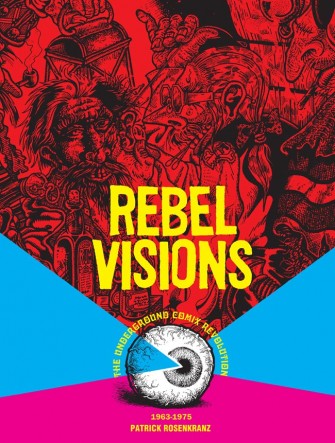
*****
As much as this decade's boom in bookstore interest in comics has famously worked to benefit certain cartoonists, we may sometimes forget that there's also been a mini-boom for writers about comics. Patrick Rosenkranz not only saw his
Rebel Visions published in coffee table, hardcover form after years of waiting to make such a book; a second, paperback edition that's out as we speak actually expands on his authoritative treatise with increased attention to those comics' visual allure. Rosenkranz has gone on to write a biography of Greg Irons in
You Call This Art?! and has just turned in a manuscript for a book about
Rand Holmes that should see publication from Fantagraphics sometime in 2009. It may be hard to believe, but the taboo-shattering, personally expressive
undergrounds are now further in our past than the beginning of the comic book itself was in those cartoonists' collective rear view mirror. I greatly enjoyed the following exchange and urge you to check out Patrick's work. The new edition of
Rebel Visions we talk about here should be available for pre-order at your comics shop or local bookseller even as we speak and should hit shelves well before Memorial Day. -- Tom Spurgeon
*****
TOM SPURGEON: How was the experience of having the book out that first time? I know that it was long time coming.
PATRICK ROSENKRANZ: My first book on comix was
Artsy Fartsy Funnies, originally titled
Komix Kountermedia, which was supposed to be published by
Crown Publishers in 1973, but instead it ended up getting thrown together sloppily by Dutch comic book publisher Paranoia in 1974 under that title. The whole experience was a real disappointment, except for getting to know the underground cartoonists. In 1998 I got a call from an editor at
Kitchen Sink Press who said he was holding a copy of
Artsy Fartsy Funnies in his hand. He asked me if I could make a bigger and better book about underground comix, and I said I'd been waiting 25 years for someone to ask me that question. I told him yes. I revisited all my research materials and renewed contact with the underground cartoonists who were still alive. Of course, as you probably know, KSP went out of business a year later.
Then I got a call from
Gary Groth asking if
Fantagraphics could publish it. I said yes again. The summer of 2002, when we were putting
Rebel Visions together in Seattle, was a very exciting time for me. I was high on life. It was supposed to come out two months before Christmas, but there was a dock strike on the West Coast and shipments from Asia, including my precious cargo were stuck out at sea for the duration. The boxes of books finally made it to the Fantagraphics warehouse about two weeks before Christmas 2002 and I had my first book signing at
CounterMedia in Portland on December 20th. It was a real thrill to see it as a large coffee table hardbound book.
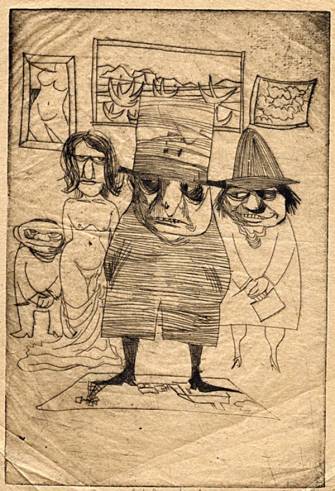 SPURGEON: Why a second volume?
SPURGEON: Why a second volume?
ROSENKRANZ: We planned to release it in paperback after the hardcover sold out, which took a while. When Gary Groth offered to redesign the book for the soft cover edition, I jumped at the chance to correct some errors and improve the presentation.
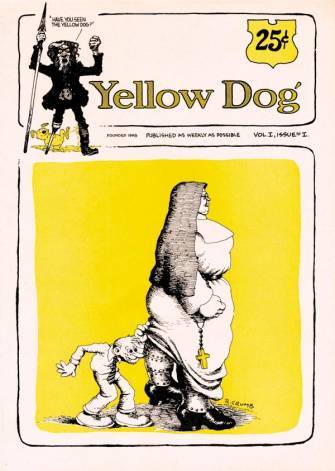 SPURGEON: How much material was added to the second volume? Were there any changes to the text?
SPURGEON: How much material was added to the second volume? Were there any changes to the text?
ROSENKRANZ: When they assigned
Greg Sadowski to be editor/designer of the second edition I began to understand how effectively good design can enhance and reinforce the content of a book. Sadowski took a very different approach than Carrie Whitney who designed the hardcover. First of all, he knew something about the subject and was a fan of the undergrounds. He asked me to rewrite some sections to clarify points or add additional information. He moved chapters around to give a better flow to the story, and talked me into dropping the endnotes to make it seem less like a textbook. I substituted a Recommended Reading List instead, which retains the links to full interviews. We had many fruitful discussions on the phone during the process. He was very particular that the text and images relate to each other on every page and challenged me to carefully re-examine my theories and interpretations of events during the comix movement. I was willing to spend the necessary time to chase down facts and find appropriate illustrations and write captions because I saw this as a great opportunity. Fantagraphics was very generous to make the offer to redesign my book. They could have just slapped on paper covers and re-issued the same book, but instead they chose to invest time and money on this project to make it better. I think this demonstrates their integrity and professionalism and I love them for it.
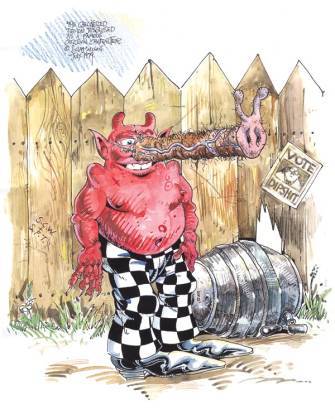 SPURGEON: The major difference that I can tell between the two editions is that this one is a lot more visually aggressive in terms of its layouts and the number of graphics included. Are you happy with the way the new edition looks? Was part of the appeal of doing a new edition showing off a lot more art?
SPURGEON: The major difference that I can tell between the two editions is that this one is a lot more visually aggressive in terms of its layouts and the number of graphics included. Are you happy with the way the new edition looks? Was part of the appeal of doing a new edition showing off a lot more art?
ROSENKRANZ: Do you realize that the paperback edition has more illustrations than the hardcover, but fewer pages? There was very little white space left over when Sadowski was finished with it. The pages are packed with visual and written information. It contains 30 percent more calories and cheap thrills. I am very happy with its new look. Some illustrations made the crossover from the first edition, but many were dropped and replaced by others. I also tried to represent additional artists who don't appear in the first edition. The best thing about all the new illustrations is that people who bought the hardcover will now also have to buy the paperback or they'll miss all the rare and interesting drawings. The index is really much better now, too.
SPURGEON: The more I read, the more I was impressed by the range of work on display. Was this material from your personal collection?
ROSENKRANZ: Much of it came from the Rosenkranz Archives, but there are several other comic collectors who were very generous with their assistance and eager to contribute to the historical record. They include Denis Wheary, Eric Sack, Glenn Bray, Pat Brown, Dave Moriaty, and Charles Boucher.
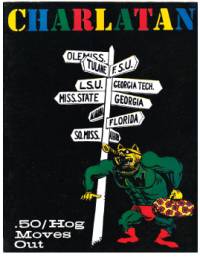 SPURGEON: One section of the book I greatly enjoyed was how you traced the roots of some of underground comix publishing to college humor magazines. Patrick, what eventually happened to those magazines, and is there a reason they didn't to contribute to comics as greatly as they did during that one time? What I mean is, I don't know of any non-underground cartoonists who got their start there, and I don't think most of them are around anymore.
SPURGEON: One section of the book I greatly enjoyed was how you traced the roots of some of underground comix publishing to college humor magazines. Patrick, what eventually happened to those magazines, and is there a reason they didn't to contribute to comics as greatly as they did during that one time? What I mean is, I don't know of any non-underground cartoonists who got their start there, and I don't think most of them are around anymore.
ROSENKRANZ: Monty Python member
Terry Gilliam edited
Occidental College Fang when he was at UCLA and later became the assistant editor at
Help! magazine.
Harvey Kurtzman offered his job to Crumb when Gilliam left. Then there are all the guys who worked on the
Harvard Lampoon who later formed
National Lampoon. So there's some crossover.
I think the big appeal of college humor mags in the 1960s was that they were slightly subversive and that's exciting when you're on your own for the first time. Students were always trying to get around university censors and push the limits of polite journalism. At UT Austin, the entire editorial staff of the
Texas Ranger was fired in 1961 when they slipped the F-word into an illustration. Plus, being on the
Ranger staff meant having big parties when the money from sales of new issues came in. What could be more attractive than that? When Bill Killeen started
Charlatan, the college humor mag with no college, he had the advantage of no faculty advisors. He rapidly rose to the challenge by posing his circulation manager Pam Brewster totally naked in the centerfold of the Renaissance of Croquet issue.
Charlatan was sold all across the South. When the underground press began around 1966, college humor magazines became obsolete. They didn't go far enough.
 SPURGEON: Is there anyone in the core group of underground artists that you feel has been unfairly neglected by history? I was interested that you wrote a lot about George Metzger, for instance.
SPURGEON: Is there anyone in the core group of underground artists that you feel has been unfairly neglected by history? I was interested that you wrote a lot about George Metzger, for instance.
ROSENKRANZ: My first reaction to that question is, does any artist inherently
deserve recognition? The lessons of the past clearly demonstrate that talent and success do not always go hand in hand. Plenty of hacks have achieved great success in cartooning while geniuses go broke. So if you throw your hat in the ring, you take your chances with fickle fate and concentrate on doing your best work.
A prominent critic recently wrote that
Robert Crumb is the only artist from the underground who achieved real success and continues to produce meaningful work. I cannot agree with that point of view, but I do recognize that underground art has a limited audience. Even Crumb's books only sell an average of 10,000 copies. You can still buy first-run comix from the early 1970s on eBay for five bucks or less. Despite a few exceptions, they haven't really gone up in value like
Marvel comics from that same period.
I admire many of the underground artists who chose to create highly personal work for their own reasons. If their names are obscure now, that doesn't diminish their work. It just makes it harder to find. That's why I write about them -- so they won't be forgotten by history.
Rebel Visions names over 175 cartoonists, and has detailed information about 60 of them. I sometimes get complaints from people whose participation wasn't mentioned, but I chose to concentrate on those who had the most influence, in my opinion.
 SPURGEON: Is there anyone that was more peripherally involved in underground comix that you wish had done more work or that you think had promise that wasn't quite fulfilled?
SPURGEON: Is there anyone that was more peripherally involved in underground comix that you wish had done more work or that you think had promise that wasn't quite fulfilled?
ROSENKRANZ: James Osborne, now known as the Black Prince of the Underground, was a prime example of an artistic path not followed. He drew some incredible stories before he dropped out of the underground and became a menial laborer, working as a longshoreman, espresso machine repairman and finally as a gas jockey just before his death in 2001. I wish
Richard Corben had done more work in underground titles, but the money wasn't there. They offered him better rates in New York and he went that way.
Joel Beck and
Roger Brand succumbed to the sauce and drank themselves to death. Speed and junk took out a few others.
Greg Irons was on the cusp of great success as a tattoo artist when he got struck by a bus in Thailand.
 SPURGEON: One thing I liked about your book is that you deal with Art Spiegelman fairly early on instead of how he's usually treated, as figure the underground's late period. Spiegelman was slightly younger than most of the underground cartoonists, but what do you feel his importance was during that period? Was there a difference, do you think, between the underground cartoonists based on age?
SPURGEON: One thing I liked about your book is that you deal with Art Spiegelman fairly early on instead of how he's usually treated, as figure the underground's late period. Spiegelman was slightly younger than most of the underground cartoonists, but what do you feel his importance was during that period? Was there a difference, do you think, between the underground cartoonists based on age?
ROSENKRANZ: Art Spiegelman went down to the
East Village Other while he was still in high school, but they told him his work didn't have enough sex or drugs in it. He said he didn't have any personal experience to draw on at that time, but made up for it a few years later. One of his important early contributions to the underground movement was his connection to
Topps bubble gum. He had been designing confectionery novelties for them for years before he met Crumb and
[Kim] Deitch and
Spain [Rodriguez] and
[Trina] Robbins and the other
EVO artists. He introduced them to Woody Gelman, who hired them for assignments like
Wacky Packages and Funny Little Joke Books, which paid a lot better than
EVO.
During the early '70s, Spiegelman illustrated fiction stories under the name Skeeter Grant for
Dugent, which published men's magazines
Dude,
Nugget, and
Gent. He acquired additional assignments for some of his friends, including
Bill Griffith,
Jay Lynch,
Justin Green, Trina Robbins, and Jim Osborne. Once more he helped provide paychecks. He did it again with
Douglas Comix when he solicited work from his colleagues for this catalog of Douglas Communications records and books, which paid four times the rate
Print Mint was offering.
Creating
Arcade magazine with Bill Griffith was one of his finest contributions to the underground movement. They saw it as a life raft that would rescue comix from a rising tide of economic and legal difficulties. It was a desperate measure, but done nobly.
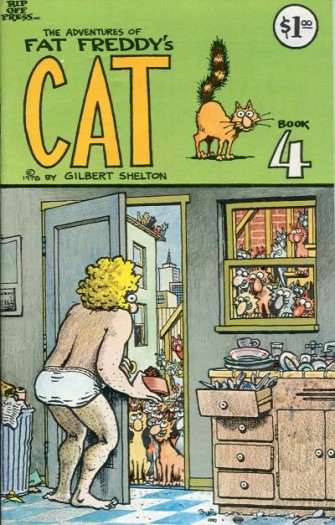 SPURGEON: Am I right in my assumption that very little underground work has been printed in archival form, especially when compared to the heavy reprinting of newspaper strips and American mainstream comics? Is there an enormous storehouse of material yet to be published, do you think, or are those comics better left to history? If you had a choice on what to re-publish, to re-introduce to the market, which comics would you choose?
SPURGEON: Am I right in my assumption that very little underground work has been printed in archival form, especially when compared to the heavy reprinting of newspaper strips and American mainstream comics? Is there an enormous storehouse of material yet to be published, do you think, or are those comics better left to history? If you had a choice on what to re-publish, to re-introduce to the market, which comics would you choose?
ROSENKRANZ: Some of the underground cartoonists have been more diligent in keeping their work in print than others. The
Complete Crumb volumes and the sketchbook series have sealed the deal for Crumb. Robert Williams has several big art books reproducing almost all of his comics and paintings. Everything
Gilbert Shelton ever drew is still in print, in numerous forms and multiple languages. Every issue of
Zap Comix is still available in comic book form.
S. Clay Wilson and
Victor Moscoso recently issued retrospective books, and Kim Deitch and Art Spiegelman have produced several fine art books in recent years. These guys are equipped to survive another century in art history, but I was surprised at how quickly some other names were forgotten. You are correct in assuming that there is a lot of unseen underground art out there. I brought Greg Irons back from the dead recently with his retrospective,
You Call This Art?! and I’m doing the same for Rand Holmes, but I can't save them all. Dan Nadel put together a book about Rory Hayes that's coming out this year. I'd like to see paperback collections of work by Dave Sheridan, Willy Murphy, Jay Lynch, Jim Osborne, Jack Jackson, George Metzger, and some others, but as my publisher reminds me, "these second tier underground artists never sell."
Some underground-era comix can stand the test of time, but much of it looks crude in hindsight. A strong editorial hand would be required.
 SPURGEON: Can you talk about your own experience with underground comix? You were around at least to take photos in 1972.
SPURGEON: Can you talk about your own experience with underground comix? You were around at least to take photos in 1972.
ROSENKRANZ: I got my first exposure to underground comix in the
East Village Other in 1966, while I was a student at Columbia University. The
SDS guys used to leave them behind in the cafeteria and I picked them up and read
Sunshine Girl and
Trashman. Pretty soon I was going down to the Lower East Side every weekend to buy the new issues. I lived in the
Haight-Ashbury in February 1968 when Crumb came out with the first
Zap Comix. After that I was hooked. The first thing I wrote about them was a pair of articles for an underground paper called
The Fountain about two of my favorites, Kim Deitch and
Skip Williamson. I heard from Jay Lynch shortly after that and he put me in touch with other cartoonists and publishers. In 1972 I decided to write a book and began doing interviews and shooting portraits. I went to Chicago, Milwaukee, New York, and San Francisco and looked up everybody I could find and talked to them. I still bought and read comix after my 1974 book came out, but started to lose interest in them during the 1980s. After that I kept track of my favorite artists peripherally, and only bought the books that I really liked. I don't draw comics, but I produced several photo funnies for
Harpoon and
Apple Pie magazines in the late 1970s.
SPURGEON: Some of Denis Kitchen's statements I found really interesting -- was there a regionalism to underground comix? It seems like there was a big difference between undergrounds in San Francisco and New York and undergrounds emerging from everywhere else.
ROSENKRANZ: Comix came of age in New York at the East Village Other. They had the best cartoonists. The
Berkeley Barb and the
LA Free Press had comix too, but
EVO had them beat in the funny business. Kim Deitch and Spain Rodriguez comix appeared most every week from 1967 through 1970. Crumb drew covers and strips whenever he was in town. Same with Gilbert Shelton, Jay Lynch, John Thompson and others. When
EVO published the tabloid-sized comic book
Gothic Blimp Works in 1969 everyone of note in the underground and even a few renegades from the overground eagerly submitted work. There was never a rivalry between the New York and California contingents of cartoonists, because before long they all moved to San Francisco.
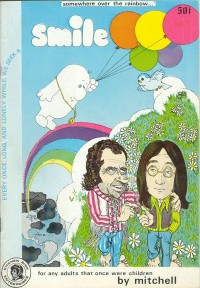
Yes, there was some Krupp bashing in San Francisco. Some sniping came back from the Midwest, too, but eventually everyone made nice and became best friends forever. What really happened was that Kitchen agreed to let Print Mint publish the second edition of
Mom's Homemade Comics #1 but then he didn't like their bookkeeping, so he decided to keep his work in Wisconsin. Pretty soon he was putting out more titles, like
Smile and
Deep 3-D Comics and
Mom's #2. Krupp Comic Works, soon to be renamed Kitchen Sink Press, became one of the few and proud underground publishers, joining
Rip Off Press,
Last Gasp Eco-Funnies, Print Mint, Apex Novelties, and the San Francisco Comic Book Company. When you put them side by side, the Krupp stuff looked kinda tame in comparison to
Zap and
Snatch. Eventually that changed, but for a while the boys in the Midwest were the occasional subject of scorn.
Bizarre Sex,
Homegrown Funnies,
Dope Comix and other Kitchen Sink titles soon closed the gross-out gap.
When work became scarcer, any port looked good to ride out the storm. Some hard core cartoonists made fun of
Comix Book, the underground hybrid comic magazine for Marvel, but they submitted work. Bill Griffith wrote a letter that was printed in issue #3, in which he describes their content as "watered-down, feeble (no -- crippled) underground comix," and yet his Claude Funston strip appears on the back cover in color.
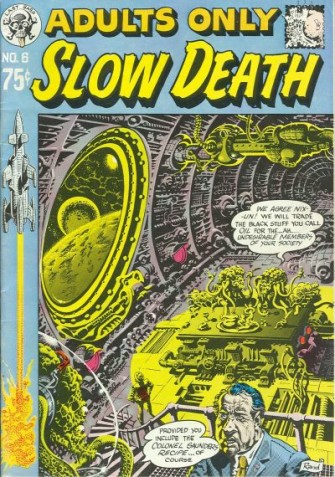 SPURGEON: How do you feel about the shots Bill Griffith took at a lot of later underground artists, concerning their adherence to an EC model of doing stories. Do you feel he had a point? Would the undergrounds have been better off with a more rigid aesthetic range?
SPURGEON: How do you feel about the shots Bill Griffith took at a lot of later underground artists, concerning their adherence to an EC model of doing stories. Do you feel he had a point? Would the undergrounds have been better off with a more rigid aesthetic range?
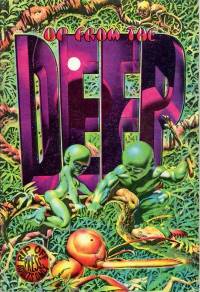 ROSENKRANZ
ROSENKRANZ The
Slow Death/
Skull Comix core cadre included
Jaxon,
Dave Sheridan, and Greg Irons. Spain Rodriguez, George Metzger, and Rand Holmes were also frequent contributors. They staked out these two titles as their turf to reinvigorate the horror and science fiction genres, that were personified by the EC Comics titles of the 1950s, only this time they would go much further in the gore and include a lot more sex. Was this a bad thing? Hell no! They drew some great comic and even pulled Richard Corben into their clammy bosoms.
Up From the Deep, another horror title from Rip Off Press, was one of the first underground comic books with color pages.
Bill Griffith wanted to define underground comix in his own terms. Nothing wrong with that either. The problem arose when he tried to impose these standards on his colleagues and take them to task. Griffith was comfortable being judgmental and critical, and willing to escalate a Balkan-style warfare. He pictured a more intellectual future for comix, where some thought was required of readers to interpret the subtext of the work. He didn't think much of the funny hippie dope comics either and superheroes were just thinly disguised homoerotic fantasies. And the idea that the
Air Pirates would dare to ape
Herriman and
Sterrett and
Disney just steamed his clams.
SPURGEON: The notion that in the mid-1970s there was too much bad stuff coming interests me because it suggests that there may have been two different values to the overall publishing output of that period: value as a kind of literary movement, and value for the culture represented by those comics, good or bad. Do you agree with that conventional wisdom that there were too many bad comic book coming out? What didn't work about the comics that were the bad ones?
ROSENKRANZ: It was the too many rats in a cage syndrome. By 1973 there were 200 people calling themselves underground cartoonists and competition for pages in popular comix increased dramatically. New titles appeared to meet the demand but they glutted the marketplace. There was disagreement on which ones were good and which were bad, but a lot of them really were stinkers. And yet some of the worst titles sold so poorly at that time that they now fetch high prices from collectors because of their rarity.
Baloney Moccasins for instance, or
Googiewaumer, or
Suds. Someone sitting on a pile of
Googiewaumers today might think they're pretty good comics, but if you apply the high standards of innovation, draftsmanship, and audacity that defined the
Zap group, too many newcomers were coming up short.
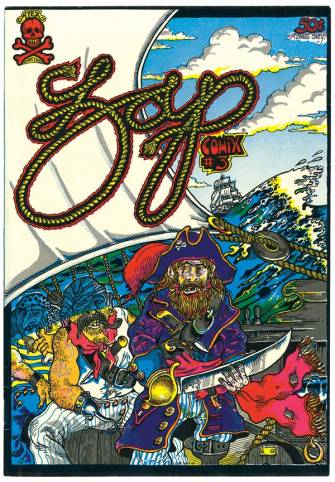 SPURGEON: Do you think underground comics would have lasted a while longer, as argued, if
SPURGEON: Do you think underground comics would have lasted a while longer, as argued, if Zap
had opened wide the doors to publishing more cartoonists' work? In general, did the underground comix era end before it had to?
ROSENKRANZ: Zap Comix was where everybody wanted to be published, but by issue #4, the collective had closed its rolls. Crumb, Wilson, Griffin, Moscoso, Shelton, Rodriguez, and
[Robert] Williams didn't want to slice the pie any thinner. After
Zap #5 came out in 1970, production of new issues slowed way down. It was three years before the appearance of
Zap #6, and a full year between
Zap #7 and
Zap #8.
Zap #9 didn't came out in until 1978. Some theorists point to this period of time as a missed opportunity to extend the underground by producing
Zap, its best-known title, on a more frequent schedule. I think that treating
Zap as a gravy train would have quickly lowered the quality. I remember looking forward to each new issue of
Zap because I knew it contained only the masters. Crumb got a chance to try out this "more inclusive" theory with
Weirdo magazine in the 1980s, and he had a hard time finding ten thousand buyers for each issue.
 SPURGEON: It struck me recently that it's 40 years since these comics started coming out, longer than that in some cases. Do you think that the legacy of underground comix has been fully established by now, or do you think that there's still a greater or different appreciation yet to come? In your own legacy section, with whom do you mostly agree?
SPURGEON: It struck me recently that it's 40 years since these comics started coming out, longer than that in some cases. Do you think that the legacy of underground comix has been fully established by now, or do you think that there's still a greater or different appreciation yet to come? In your own legacy section, with whom do you mostly agree?
ROSENKRANZ: Underground comix will have a limited legacy because they're just too dirty for most people. They're often brutal, obscene, seditious, and extreme, which is both their crowning glory and their bane. Their influence on relaxing censorship in other media was more obvious in the 1970s and 1980s, because today people are sheepishly handing over those same hard won freedoms for magic beans in the so-called War on Terror. There will always be someone trying to repress them because they might have a bad influence on the kids.
On the other hand, there is a rising academic interest in the comix movement, so their legacy may live on in art schools and English departments. I think they will also eventually transition from comic history to art history as their long-term effects on other fine artists are noted. I also think that original artwork will jump in value in the near future.
People who read them when they first came out remember the initial impact -- like getting whacked in the head with a two by four. After you recovered from their shock, you looked around for more. When those people die, we'll have to rely on the written record. When I read about all the fuss surrounding those Danish cartoons of Allah, I wonder, haven't these people ever seen S. Clay Wilson?
 SPURGEON: Tell me about your Rand Holmes biography. When's it coming out? What don't we know about Rand Holmes?
SPURGEON: Tell me about your Rand Holmes biography. When's it coming out? What don't we know about Rand Holmes?
ROSENKRANZ: I handed in my manuscript recently so I imagine it will be spring 2009 before it appears in print. Rand Holmes was a private and secretive man who was self taught in everything he did, which was more than comics. He also played the banjo, tamed birds, hunted with black powder rifles, and built his own house from logs harvested on his property on a remote island in British Columbia. He produced hundred of covers and illustrations for the
Georgia Straight during the 1970s, drew comics for
Death Rattle and
Twisted Tales in the 1980s and painted in the style of the old masters during the 1990s.
His widow Martha gave me complete access to his artwork, personal papers, journals, and correspondence because she wanted me to understand him. I compiled his career spanning work from many sources to reproduce in this book, and interviewed his family, high school buddies, fellow cartoonists, wives and girlfriends, to assemble a very revealing portrait of a complicated man. I think you'll enjoy it.
*****
* cover to new edition of
Rebel Visions
* Frank Stack drawing
* cover to
Yellow Dog
* Checkered Demon/Wonder Wart-Hog "crossover"
*
Charlatan cover
* George Metzger cover
* Joel Beck
* Art Spiegelman
* Spain Rodriguez
* one of the early Krupp/KSP efforts
* two in the EC/Underground tradition
* Zap
* S. Clay Wilson sequence
* a Rand Holmes gag cartoon
* R Crumb cover
*****
Rebel Visions: The Underground Comix Revolution 1963-1975, Revised & Expanded Edition, Patrick Rosenkranz, Fantagraphics, soft cover, 292 pages, 156097706X (ISBN10), 9781560977063 (ISBN13), May 2008,
*****
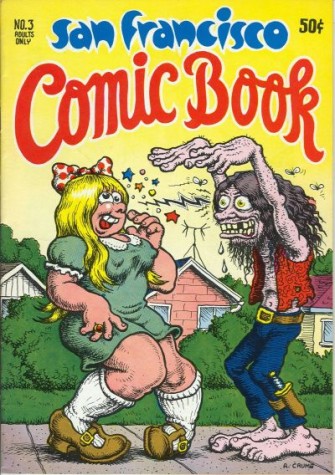
*****
*****


